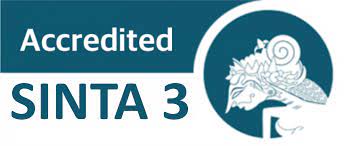The Use of Livemocha: A Platform for Independent Language Learning
Abstract
The Covid -19 pandemic has affected all aspect of human’s life including the educational institution. All the activities are then held mostly online. Many online platform are used as a tool to interact between teacher and students. Despite their massive growth in online teaching, little research has been conducted about the use of online language learning community in learning foreign language. The aim of this study is to examine the use of Livemocha to learn foreign language independently. This study uses autoethnography method which uses the researcher personal experience to describe and analyze the data. Result of this study shows that the site is useful for learning English independently. This study concludes with suggestions for English Learning through social networking site.
Keywords
Full Text:
PDFReferences
Abrams, Z. I. (2001). Computer-mediated communication and group journals: Expanding the repertoire of participant roles. System, 29(4), 489–503. https://doi.org/10.1016/S0346-251X(01)00041-0
Calviño, M. A. M. (2012). Content and language integrated learning. Tlatemoani: revista académica de investigación, 9, 7.
Chwo, S.-M. G., Marek, M. W., & Wu, W.-C. V. (2016). Curriculum Integration of MALL in L1/L2 Pedagogy: Perspectives on Research. Journal of Educational Technology & Society, 19(2), 340–354.
Clark, C., & Gruba, P. (2010). The use of social networking sites for foreign language learning: An autoethnographic study of Livemocha. 164–173. https://www.learntechlib.org/p/45384/
Crew, V. (2017). The Nature, Implementation and Potential of Short Term Overseas English Language Immersion. https://www.academia.edu/47988243/The_Nature_Implementation_and_Potential_of_Short_Term_Overseas_English_Language_Immersion
Egel, İ. P. (2019). Learner autonomy in the language classroom: From teacher dependency to learner independency. Procedia - Social and Behavioral Sciences, 1(1), 2023–2026. https://doi.org/10.1016/j.sbspro.2009.01.355
Ellis, C., Adams, T. E., & Bochner, A. P. (2011). Autoethnography: An Overview. Forum Qualitative Sozialforschung / Forum: Qualitative Social Research, 12(1), Article 1. https://doi.org/10.17169/fqs-12.1.1589
Ellis, N. C. (2008). The Dynamics of Second Language Emergence: Cycles of Language Use, Language Change, and Language Acquisition. The Modern Language Journal, 92(2), 232–249. https://doi.org/10.1111/j.1540-4781.2008.00716.x
Felix, U. (2005). E-learning pedagogy in the third millennium: The need for combining social and cognitive constructivist approaches. ReCALL, 17(1), 85–100. https://doi.org/10.1017/S0958344005000716
González-Lloret, M. (2013). Conversation Analysis of Computer-Mediated Communication. CALICO Journal, 28(2), 308–325. https://doi.org/10.11139/cj.28.2.308-325
Irham, I. (2018). ASSESSING LIVEMOCHA AND DUOLINGO EVALUATION TASKS: ADAPTING CHAPELLE CALL ASSESSMENT CRITERIA IN AUTONOMOUS LEANING EXPERIENCE. Erudio Journal of Educational Innovation, 5(1), 103–114. https://doi.org/10.18551/erudio.5-1.13
Jee, M. J., & Park, M. J. (2013). Review of Livemocha as an online language-learning community. CALICO Journal, 26(2), 448–456. https://doi.org/10.1558/cj.v26i2.448-456
Lloyd, E. (2012). Language Learners’ “Willingness to Communicate” through Livemocha.com. Alsic, Vol. 15, n°1. https://doi.org/10.4000/alsic.2437
Negretti, R. (1999). Web-based Activities and SLA: A Conversation Analysis Research Approach. Language Learning & Technology, 3(1), 75–87.
Raento, M. (2015). Designing for privacy and self-presentation in social awareness. Personal Ubiquitous Comput., 12(7), 527–542.
Reinders, H., & White, C. J. (2011). Learner autonomy and new learning environments. Language, Learning and Technology, 15, 1–3.
Schmit, C. (2017). Livemocha and the power of social language learning. International House Journal of Education and Development, 28. http://ihjournal.com/livemocha-and-the-power-of-social-language-learning
Sumalatha, D. (2013). A NEW MEDIA TO EXPLORE ENGLISH LANGUAGE LEARNING SKILLS A PERSPECTIVE APPROACH. Research Journal of English Language and Literature, 1(1), 143–148.
Van Lier, L. (2014). The ecology and semiotics of language learning: A sociocultural perspective. Dordrecht.
Wilkinson, S. (2014). On the Nature of Immersion During Study Abroad: Some Participant Perspectives. Frontiers: The Interdisciplinary Journal of Study Abroad, 4(1), 121–138. https://doi.org/10.36366/frontiers.v4i1.65
Yadav, M. (2021). Role of Social Media in English Language Learning to the Adult Learners. Internation Journal of Linguistics, Literature and Translation (IJLLT), 4(1), 238–246.
DOI: https://doi.org/10.18860/abj.v7i1.15234
Refbacks
- There are currently no refbacks.
Copyright (c) 2022 Abjadia

This work is licensed under a Creative Commons Attribution-NonCommercial 4.0 International License.
...............................................................................................................................................................
Mailing Address:
Ruang Jurnal Abjadia, Fakultas Ilmu Tarbiyah dan Keguruan (FITK)
Universitas Islam Negeri (UIN) Maulana Malik Ibrahim Malang
Jalan Gajayana 50 Malang 65144, Jawa Timur, Indonesia
Phone/Faximile: (+62341) 552398, Phonsel: +6281333666063
Website: http://ejournal.uin-malang.ac.id/index.php/abjadia
Email: abjadia@uin-malang.com
Abjadia: International Journal of Education. This work is licensed under a Creative Commons Attribution-ShareAlike 4.0 International License.
...............................................................................................................................................................
Indexed by:






